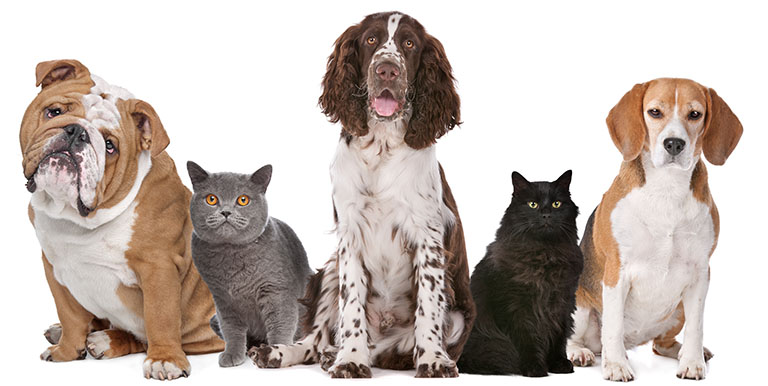The desire for four-legged companionship can often conflict with the fear of triggering allergic reactions. While hypoallergenic pets are sought after as a potential solution, the reality behind these breeds is more nuanced than meets the eye. Understanding the complexities of pet allergies and the myths surrounding hypoallergenic pets is essential for making informed decisions when choosing a new cat or dog.
This blog dives into the details of pet allergies, the truth of hypoallergenic breeds and offers guidance on finding the ideal companion that won’t trigger your allergic reactions.
Cat and Dog Allergies
Allergic reactions to pets can manifest in symptoms such as nose and eye itchiness, a runny nose, sneezing, rashes, coughing and nasal congestion. The severity of these symptoms varies among individuals. People who are allergic to pets experience these signs when in the same space as the animal or come into physical contact with the cat or dog’s hair or fur. Approximately 10-20% of the global population is allergic to cats and dogs.
Contrary to common belief, it’s not the hair or fur of cats and dogs that triggers allergies. The culprit is a protein present in the animals’ dander, which includes saliva, urine and dead skin cells. The length, type, style or shedding of the coat has no direct correlation with the onset of allergic symptoms. When pets lick themselves, scratch their skin or use the bathroom, they release the allergenic protein into the air and onto surfaces.
It’s worth noting that dog allergens can differ between breeds. For instance, someone allergic to Labrador retrievers might not experience the same reaction to a Maltese. On the other hand, cats generally share a common protein known as Fel d 1, which serves as the primary allergen responsible for nearly all cat allergies.

What is a Hypoallergenic Pet?
A hypoallergenic pet is supposed to be an animal that is less likely to cause allergic reactions in people who are typically sensitive or allergic to cats or dogs. These pets are often characterized by having hair instead of fur, producing less dander or having a particular coat type that minimizes shedding. The popularity of certain breeds and mixed breeds touted as hypoallergenic has increased over the years as people become more aware of allergies associated with pets.
Are There Truly Hypoallergenic Dog and Cat Breeds?
While many people seek hypoallergenic dog or cat breeds to mitigate allergic reactions, it’s crucial to recognize that there isn’t a definitive 100% hypoallergenic pet. Despite certain breeds being less prone to shedding or producing less dander, labeling them as completely hypoallergenic is inaccurate. Shedding and dander production are inherent traits among all dogs and cats in varying degrees. Some breeds may trigger fewer allergic reactions in certain individuals, but there is no guarantee of complete immunity for all. Allergies are complex and multifaceted, influenced by various factors including genetics, environment and individual sensitivities. Developing a breed that is universally safe for every individual with a pet allergy is highly challenging, if not impossible.

Why are People Less Allergic to “Hypoallergenic” Pets?
There is a consensus regarding why certain breeds are better suited for owners with allergies. Breeds that shed less hair tend to cause fewer allergic reactions because the dander and saliva remain largely confined to the hair that stays within the hair follicle.
The shedding process plays a significant role in the distribution of allergens. When pets shed less, there’s a reduced likelihood of allergens becoming airborne and triggering allergic responses in susceptible individuals. The hair follicle acts as a natural barrier, containing the allergens to a greater extent than breeds with higher shedding rates. Breeds that produce less dander and saliva may also contribute to lower allergen exposure.
How to Know if You Are Allergic to a Certain Breed
Understanding that allergic responses differ among individuals, experts recommend interacting with the specific breed of cat or dog you’re interested in before making a commitment. This hands-on approach allows you to gauge your personal reaction and sensitivity levels to the animal. Allergy testing can provide information about allergic reactions to dogs and cats, but it cannot specifically identify the breeds that are the biggest culprits. By spending time with the prospective pet, you can better assess whether you’ll develop allergies in its presence.

Common Less-Allergenic Cat and Dog Breeds
In the quest for less-allergenic pets, certain cat and dog breeds have garnered attention for potentially causing fewer allergic reactions. For cats, breeds such as Siberian, Siamese, bengal, Russian blue, sphynx, Devon rex, Cornish rex, Javanese, Balinese, Oriental shorthair and Burmese are often considered less-allergenic due to their reduced tendency to produce allergenic proteins.
Similarly, in the world of dogs, several breeds are frequently labeled as “hypoallergenic”. These include affenpinscher, Afghan hound, American hairless terrier, barbet, Bedlington terrier, bichon frise, giant and miniature schnauzer, Maltese, poodle (toy, mini and standard sizes), Portuguese water dog, Yorkshire terrier and various doodle mixes.

Where to Find a “Hypoallergenic” Pet
When beginning the journey of finding the perfect furry companion, it’s important to start your search in the right places. Explore reputable breeders who specialize in the breed you are interested in welcoming into your home. If adoption is your preferred route, consider joining waiting lists or signing up for notifications when specific breeds become available at shelters. Many breed-specific rescue organizations provide wonderful opportunities to adopt pets that align with your lifestyle and preferences. By investing the time and having patience to find the perfect match, you’re ensuring a lifelong bond between you and your new four-legged friend.
A Chance at Pet Ownership
Understanding that pet allergies vary greatly among individuals helps prospective pet owners to approach pet ownership with clarity and insight. While there’s no universal solution for pet allergies, embracing the diversity of breeds and considering options that suit individual sensitivities and preferences can lead to finding the perfect match. Although no breed is entirely hypoallergenic, exploring less-allergenic options provides hope for those with allergies to fulfill their dreams of becoming dog or cat owners.




